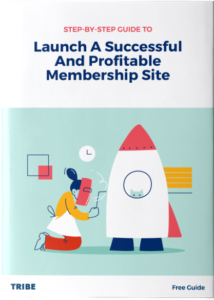6 Ways to Make Money With Your Membership and Set Yourself Up for Success
It’s the topic no one likes to talk about, but one we all have to talk about to run a membership site business: MONEY.
At the beginning stages of offering a service or product or membership, the question always comes back to pricing.
How much should I charge?
How do I charge it?
Do I charge monthly or annual or a one time fee or a trial?
Don’t worry, we have you covered.
Deciding what to price and how to price is actually pretty simple. So let’s get into the six different pricing models and how to pick the one that’s right for you and your market—and your starting price point.

6 Ways to Price Your Membership
1. Monthly
This is your typical membership where members are paying each and every month in order to have access to your content. It’s pretty straightforward.
2. Annual Pricing
A familiar case study is Amazon Prime. They follow an annual pricing model where customers pay once per year and it renews every year.
3. Combined Pricing
Now your members have a choice: they can pay on a monthly basis OR they can pay on an annual.
If you’re offering both, a helpful tip is incentivizing the annual option.
For example, you could offer 12 months of access to your membership for the price of 10 when someone signs up annually.
4. One-time Fee
This means they would pay one time and have access to the membership site for life. It’s crazy, but many membership sites do that.
We don’t recommend this model, because, at that point, it’s not really a membership. And since you still need to support and serve your people, revenue will depreciate over time.
5. Upfront Fee with Ongoing Monthly
What some membership owners do is charge an upfront fee—let’s say $500 for enrolment—and then an ongoing monthly fee of $50.
The advantages here are two-fold:
- If you have an expensive set-up cost, the enrolment fee can balance your budget.
- It’s a way to discourage the people who join and cancel, join and cancel, join and cancel—with a fee they are more likely to stay once they’ve committed.
6. Low-dollar Trial Rolling into Monthly
You’ll often see a $1 trial and or a $7 trial or something similar.
Here’s a quick tip: if you go this route, keep the trial period pretty short. We advise a $1 trial for 3 to 7 days maximum, then roll into a regular billing period.
Now, the potential downside of trials is that they typically draw people who aren’t actually committed to the membership. On the other hand, it can be a great way to attract those who have committal qualms but need that extra security.
Just remember: it’s your responsibility to knock their socks off so they never want to leave.

Choosing a Pricing Model
So the question becomes, which one should you pick?
Here’s the reality, you can pick any of them and know that you can change it down the road.
But in the beginning, just keep it as simple as possible because the simpler it is, the easier it will be to roll it out.
What would really be bad news is making the mistake of pricing too high—then lowering your price.
What’s so bad about lowering prices?
If somebody joins at the higher price and then you drop it, thinking they’re going to be grateful… prepare for disappointment.
Think about it: when you lower the price, people who were paying a higher amount think, “Hey, shouldn’t I be refunded all of those months that I paid the higher price?”
Or “Wait a minute, why are we dropping the prices? Is the value not there?” Which leads to “Is this membership even worth it?”
We have seen it happen in all kinds of markets. But when people start low and raise prices from there, we see the opposite effect.
- You get a built-in marketing promotion every time you raise prices.
- It works as a retention strategy. Your members who got in at that lower price don’t ever want to leave—because if they leave and come back they’re going to have to pay the higher price.
The founder of TRIBE, Stu McLaren used this process when he worked with Michael Hyatt on Platform University.
Members joining within the first week started at only $20 a month. After that, the price went up to $25, then $30, then $37, and then $47. Each price increase was an opportunity for an awesome promotion.
Those initial members were grandfathered in at that price for as long as they remain members in good standing. Years later, Michael Hyatt still has people paying $20 a month because they joined during that first week.
So when it comes to pricing, our recommendation is: don’t overcomplicate it. Pick one model in the beginning and just stick with that until you compile some date and then shift as needed.
Most importantly, plan beginning prices lower than you expected and raise them over time.
This slow-grow will help you both from a marketing perspective and from a retention perspective—which in the end helps your bottom line.
Don’t get tripped up over price. The good news is if you follow this model—start low and raise it—you can get started from anywhere, anytime.
In this short clip, Stu McLaren breaks down the 6 most common membership pricing models.
Thinking about starting a membership site? Get going with this downloadable guide.
Learn the exact steps to take to build a successful membership business around what you already, know, love, and do! Ready to reclaim your time and attract a tribe of paying members?






